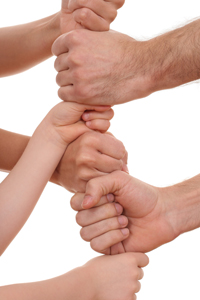What is Your Community Teaching You About Sustainability?
By Jim Strickland

Photo © matka_Wariatka/Shutterstock |
Winston Churchill said, “We shape our buildings and then our buildings shape us.” Well, the same is true for our communities. Communities that are fragmented and dysfunctional produce people who are – you guessed it – fragmented and dysfunctional. On the other hand, communities that bring people together and build connections – communities that are inclusive, nurturing and accessible – produce people who are connected and empowered.
And healthy communities don’t just happen by accident. Like Churchill said, they have to be carefully and intentionally “shaped” so that they will then shape us into the kinds of people we want to be. We build our communities around values that both reflect who we are and influence who we can become.
Another word for this shaping process is education. Education is much bigger than anything our schools can do alone. It is happening everywhere, all the time – when we read our local paper, when we walk through downtown, when we visit a local park, when we patronize a local business, when we participate in a local election. The quality of our experiences during these daily activities teaches us what our community really values and then shapes us according to those values.
So, with that in mind, here are a few questions you can ask that will give you a better idea of the kind of education your community is providing you:
1) Am I able to have a real voice in the decisions that affect me and my family, and do I know how to make my voice heard?
2) Are there a sufficient number of public places that bring the diverse members of my community together so we can build common ground?
3) Is there an ongoing and accessible public dialogue about important issues in my community, and do I know how I can participate in this dialogue?
4) Is my community thinking long-term and planning for generations to come?
5) Does my community support small businesses, economic innovation and entrepreneurialism?
6) Does my community value and support participation in the creative arts?
7) Do I have access to locally grown food and locally made products?
8) Is it possible for me to both live and work in the same community?
9) Is my community safe for walking and biking? Can I get many of my basic needs met without using my car?
10) Do people of all ages, from children to senior citizens, have regular opportunities to work and play together? Is the knowledge and wisdom of our elders being respected and utilized?
11) Are there opportunities for everyone, no matter what their ability level, to do real work and make real contributions?
12) Does my community take care of its own – the sick, the needy, the weak, the disabled?
13) Does my community respect and foster sustainable connections with the natural world?
Questions like these can create the conversations we need to be having, and it is in these conversations that we will discover the work that needs to be done. Democracy doesn’t just happen by accident. There has to be an infrastructure in place that both allows and helps it to happen. And when these “buildings” have been shaped, they will then shape us into the educated and empowered citizens that can make our communities – and our democracy – work. And isn’t that what public education really means?
Jim Strickland lives in Everett, Washington with his wife and three children. He is a community-based educator in nearby Marysville where he works to promote non-coercive learning and the development of true learning communities. Jim invites response from readers who are interested in joining the conversation on integrating learning with the rest of our lives. He can be reached at livedemocracy@hotmail.com.
|

